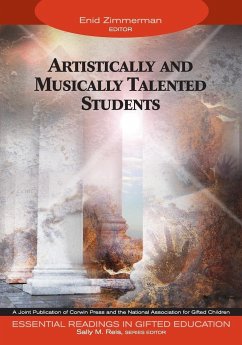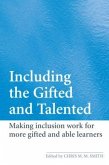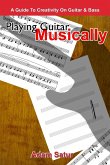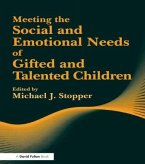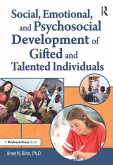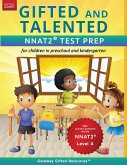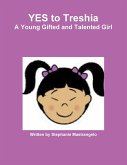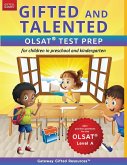- Broschiertes Buch
- Merkliste
- Auf die Merkliste
- Bewerten Bewerten
- Teilen
- Produkt teilen
- Produkterinnerung
- Produkterinnerung
Major themes include nature versus nurture in arts talent development, crystallizing experiences, teacher empowerment, and collaboration between school and community members in identifying talented art students.
Andere Kunden interessierten sich auch für
![Including the Gifted and Talented Including the Gifted and Talented]() Chris Smith (ed.)Including the Gifted and Talented67,99 €
Chris Smith (ed.)Including the Gifted and Talented67,99 €![Playing Guitar Musically Playing Guitar Musically]() Adam SaturPlaying Guitar Musically27,99 €
Adam SaturPlaying Guitar Musically27,99 €![Meeting the Social and Emotional Needs of Gifted and Talented Children Meeting the Social and Emotional Needs of Gifted and Talented Children]() Michael J StopperMeeting the Social and Emotional Needs of Gifted and Talented Children58,99 €
Michael J StopperMeeting the Social and Emotional Needs of Gifted and Talented Children58,99 €![Social, Emotional, and Psychosocial Development of Gifted and Talented Individuals Social, Emotional, and Psychosocial Development of Gifted and Talented Individuals]() Anne RinnSocial, Emotional, and Psychosocial Development of Gifted and Talented Individuals76,99 €
Anne RinnSocial, Emotional, and Psychosocial Development of Gifted and Talented Individuals76,99 €![Gifted and Talented NNAT2 Test Prep - Level A Gifted and Talented NNAT2 Test Prep - Level A]() Gateway Gifted ResourcesGifted and Talented NNAT2 Test Prep - Level A37,99 €
Gateway Gifted ResourcesGifted and Talented NNAT2 Test Prep - Level A37,99 €![YES to Treshia A Young Gifted and Talented Girl YES to Treshia A Young Gifted and Talented Girl]() Stephanie MastrangeloYES to Treshia A Young Gifted and Talented Girl30,99 €
Stephanie MastrangeloYES to Treshia A Young Gifted and Talented Girl30,99 €![Gifted and Talented OLSAT Test Prep (Level A) Gifted and Talented OLSAT Test Prep (Level A)]() Gateway Gifted ResourcesGifted and Talented OLSAT Test Prep (Level A)37,99 €
Gateway Gifted ResourcesGifted and Talented OLSAT Test Prep (Level A)37,99 €-
-
-
Major themes include nature versus nurture in arts talent development, crystallizing experiences, teacher empowerment, and collaboration between school and community members in identifying talented art students.
Hinweis: Dieser Artikel kann nur an eine deutsche Lieferadresse ausgeliefert werden.
Hinweis: Dieser Artikel kann nur an eine deutsche Lieferadresse ausgeliefert werden.
Produktdetails
- Produktdetails
- Verlag: Corwin
- Seitenzahl: 184
- Erscheinungstermin: 6. März 2004
- Englisch
- Abmessung: 254mm x 178mm x 10mm
- Gewicht: 358g
- ISBN-13: 9781412904346
- ISBN-10: 141290434X
- Artikelnr.: 21354601
- Herstellerkennzeichnung
- Libri GmbH
- Europaallee 1
- 36244 Bad Hersfeld
- gpsr@libri.de
- Verlag: Corwin
- Seitenzahl: 184
- Erscheinungstermin: 6. März 2004
- Englisch
- Abmessung: 254mm x 178mm x 10mm
- Gewicht: 358g
- ISBN-13: 9781412904346
- ISBN-10: 141290434X
- Artikelnr.: 21354601
- Herstellerkennzeichnung
- Libri GmbH
- Europaallee 1
- 36244 Bad Hersfeld
- gpsr@libri.de
ENID ZIMMERMAN is Professor Emerita of Art Education and current Coordinator of High Ability Programs at Indiana University. In her research, she focuses on art talent development, creativity and art education, art teacher education, feminist art education, leadership and mentoring, global art education, and curriculum and policy issues. She has authored over 35 articles, 20 book chapters, and 25 books and monographs and has taught or conducted workshops in more than 25 countries. She was the first NAEA Research Commission Chair and is presently an NAEA Research Commissioner. Zimmerman has received numerous university, national, and international awards; the NAEA Elliot Eisner Lifetime Achievement Award (2014) is the most recent. She also served two terms as a North American World Councilor for the International Society for Education through Art. She co-edited Connecting Creativity Research and Practice in Art Education (NAEA, 2015) and had a leading chapter published in the Handbook of Research on Creativity (Edward Elgar, 2013). In addition, Zimmerman served as editor of 14 NAEA Advocacy White Papers (2011-2012) and wrote one of them. She presently is involved developing and evaluating leadership programs for NAEA. Through the Prism: Looking at the Spectrum of Writings of Enid Zimmerman (NAEA, 2009), co-authored by Robert Sabol and Marjorie Manifold, summarizes her influences on art education through her own writings and those of her former students and colleagues.
About the Editors
Series Introduction - Sally M. Reis
Introduction to Artistically and Musically Talented Students - Enid
Zimmerman
1. Decisions Regarding Music Training: Parental Beliefs and Values - David
Yun Dai, Robin M. Schader
2. Musical Talent: Innate or Acquired? Perceptions of Students, Parents and
Teachers - Robert J. Evans, Robert Bickel, and Edwina D. Pendarvis
3. The Crystallizing Experience: A Study in Musical Precocity - Cathy
Freeman
4. Talent Beyond Words: Identification of Potential Talent in Dance and
Music in Elementary Students - Susan Baum, Steven V. Owen, and Barry A.
Oreck
5. Talent Beyond Words: Unveiling Spatial, Expressive, Kinesthetic and
Musical Talent in Young Children - Sandra I. Kay, Rena F. Subotnik
6. Identifying Artistically Talented Students in Four Rural Communities in
the United States - Gilbert Clark, Enid Zimmerman
7. Views of Self, Family Background, and School: Interviews with
Artistically Talented Students - Gilbert A. Clark, Enid Zimmerman
8. I Don¿t Want to Sit in the Corner Cutting Out Valentines: Leadership
Roles for Teachers of Talented Arts Students - Enid Zimmerman
Index
Series Introduction - Sally M. Reis
Introduction to Artistically and Musically Talented Students - Enid
Zimmerman
1. Decisions Regarding Music Training: Parental Beliefs and Values - David
Yun Dai, Robin M. Schader
2. Musical Talent: Innate or Acquired? Perceptions of Students, Parents and
Teachers - Robert J. Evans, Robert Bickel, and Edwina D. Pendarvis
3. The Crystallizing Experience: A Study in Musical Precocity - Cathy
Freeman
4. Talent Beyond Words: Identification of Potential Talent in Dance and
Music in Elementary Students - Susan Baum, Steven V. Owen, and Barry A.
Oreck
5. Talent Beyond Words: Unveiling Spatial, Expressive, Kinesthetic and
Musical Talent in Young Children - Sandra I. Kay, Rena F. Subotnik
6. Identifying Artistically Talented Students in Four Rural Communities in
the United States - Gilbert Clark, Enid Zimmerman
7. Views of Self, Family Background, and School: Interviews with
Artistically Talented Students - Gilbert A. Clark, Enid Zimmerman
8. I Don¿t Want to Sit in the Corner Cutting Out Valentines: Leadership
Roles for Teachers of Talented Arts Students - Enid Zimmerman
Index
About the Editors
Series Introduction - Sally M. Reis
Introduction to Artistically and Musically Talented Students - Enid
Zimmerman
1. Decisions Regarding Music Training: Parental Beliefs and Values - David
Yun Dai, Robin M. Schader
2. Musical Talent: Innate or Acquired? Perceptions of Students, Parents and
Teachers - Robert J. Evans, Robert Bickel, and Edwina D. Pendarvis
3. The Crystallizing Experience: A Study in Musical Precocity - Cathy
Freeman
4. Talent Beyond Words: Identification of Potential Talent in Dance and
Music in Elementary Students - Susan Baum, Steven V. Owen, and Barry A.
Oreck
5. Talent Beyond Words: Unveiling Spatial, Expressive, Kinesthetic and
Musical Talent in Young Children - Sandra I. Kay, Rena F. Subotnik
6. Identifying Artistically Talented Students in Four Rural Communities in
the United States - Gilbert Clark, Enid Zimmerman
7. Views of Self, Family Background, and School: Interviews with
Artistically Talented Students - Gilbert A. Clark, Enid Zimmerman
8. I Don¿t Want to Sit in the Corner Cutting Out Valentines: Leadership
Roles for Teachers of Talented Arts Students - Enid Zimmerman
Index
Series Introduction - Sally M. Reis
Introduction to Artistically and Musically Talented Students - Enid
Zimmerman
1. Decisions Regarding Music Training: Parental Beliefs and Values - David
Yun Dai, Robin M. Schader
2. Musical Talent: Innate or Acquired? Perceptions of Students, Parents and
Teachers - Robert J. Evans, Robert Bickel, and Edwina D. Pendarvis
3. The Crystallizing Experience: A Study in Musical Precocity - Cathy
Freeman
4. Talent Beyond Words: Identification of Potential Talent in Dance and
Music in Elementary Students - Susan Baum, Steven V. Owen, and Barry A.
Oreck
5. Talent Beyond Words: Unveiling Spatial, Expressive, Kinesthetic and
Musical Talent in Young Children - Sandra I. Kay, Rena F. Subotnik
6. Identifying Artistically Talented Students in Four Rural Communities in
the United States - Gilbert Clark, Enid Zimmerman
7. Views of Self, Family Background, and School: Interviews with
Artistically Talented Students - Gilbert A. Clark, Enid Zimmerman
8. I Don¿t Want to Sit in the Corner Cutting Out Valentines: Leadership
Roles for Teachers of Talented Arts Students - Enid Zimmerman
Index

